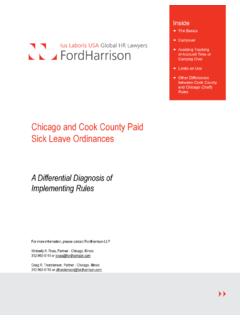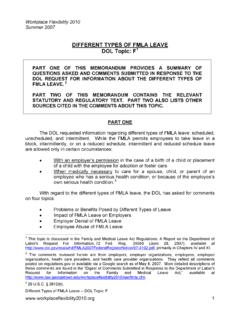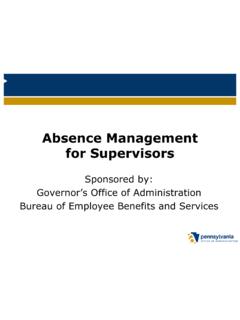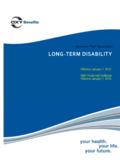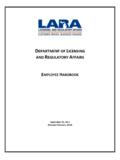Transcription of Chicago and Cook County Paid Sick Leave Ordinances
1 Inside x The Basics x x Carryover x x Avoiding Tracking x of Accrued Time or Carrying Over x Limits on Use x x Other Differences x between Cook County and Chicago Rules Chicago and Cook County Paid Sick Leave Ordinances A Differential Diagnosis of Final Implementing Rules For more information, please contact FordHarrison LLP. Kimberly A. Ross, Partner - Chicago , Illinois 312-960-6111 or Craig R. Thorstenson, Partner - Chicago , Illinois 312-960-6116 or Chicago and Cook County Paid Sick Leave Ordinances : A Differential Diagnosis of Final Implementing Rules (Updated June 30, 2017). As most employers in the Chicagoland area are hopefully already aware, both Chicago and Cook County have enacted paid sick Leave Ordinances that go into effect July 1, 2017 (The Chicago Minimum Wage and Paid Sick Leave Ordinance and Cook County Earned Sick Leave Ordinance). Although the two Ordinances are remarkably similar as written, the rules that interpret the Ordinances are somewhat different.
2 Cook County 's Interpretative and Procedural Rules went into effect on May 25, 2017. Chicago 's Minimum Wage and Paid Sick Leave Rules went into effect June 28, 2017. Employers operating in Chicago will be relieved to know that many of the draft rules have changed or have been clarified, thus making the ordinance slightly easier to understand and implement. The differences between the two sets of implementing rules may still cause some problems, however, for employers who operate both in Cook County and in Chicago . It should also be noted that as of June 30, 2017, 89 municipalities (out of 131, not including Chicago ) in Cook County have opted out of the earned sick Leave ordinance, noted here, (which is up by 23 since June 22). As will be discussed below however, employers located in opted-out municipalities may still be required to provide paid sick Leave .
3 This article will provide some of the main points in the two Ordinances that employers need to know. We have also prepared a chart that compares the two jurisdictions' rules interpreting the two Ordinances , focusing on the most important differences of which employers need to be aware. We have previously prepared more detailed articles on both Ordinances , which can be found here for Chicago and here for Cook County . This article is intended to provide an overview of each ordinance and its respective rules and is not intended to cover every aspect of the Ordinances . Employers located or doing business in either Cook County or Chicago are urged to contact their employment counsel to determine whether their current policies comply with the Ordinances ' requirements, or whether they will need to draft entirely new policies. The Basics Accrual Rate and Cap Both Ordinances require employers to provide certain employees with one hour of paid sick Leave for every 40 hours worked.
4 (Cook County 's ordinance refers to the Leave as earned sick Leave but for the sake of consistency, we will simply refer to both as paid sick Leave or PSL. Note that both sets of rules further identify and attempt to define types of PSL, which is noted in the comparison chart.) Both Ordinances set an earning cap of 40 hours in a year unless the employer chooses to allow more. Location Where Work Performed Chicago 's Ordinance applies to employers who maintain a business facility in Chicago and/or who are required to obtain a business license to operate in the City. Cook County 's ordinance applies to employers that gainfully employ at least one Covered Employee with their principal place of business within Cook County . A Covered Employee is one who performs at least two hours of work in a two-week period for an employer while physically present within Cook County .
5 For employees to be eligible under both Ordinances , they must work at least 80 hours for an employer in any 120-day period of time; thus, under both Ordinances , most part-time, non-seasonal workers will qualify. Thus, all employers in Cook County municipalities (besides Chicago ) are considered to be Covered Employers; however, such employers only need to provide PSL if they are located in a municipality that has not opted out of the ordinance, or if their employees' work is being performed in a Cook County municipality that has not opted out. Moreover, only the work performed in these jurisdictions ( Chicago and the non-opted out municipalities in Cook County ) counts toward PSL accrual, unless the employer's policy states differently. As an example, if an employer is located in Des Plaines, which has opted out, it is considered to be a Covered Employer.
6 However, the employer need not provide its employees with paid sick Leave for any work they perform in Des Plaines because Des Plaines has opted out. On the other hand, if the employer is located in Berwyn (which had not opted out as of the time FordHarrison LLP | | Revised June 2017 1. this article was drafted), then that employer must provide PSL to its employees when they are working in Berwyn (and any other non-opted out Cook County municipality), but not when they are working in Des Plaines (or another municipality that has opted out). Therefore Cook County employers in municipalities that have opted out must still also adopt PSL policies and practices if there is any possibility of their employees performing work in a non-opted-out Cook County municipality. Accrual and Accrual Period We will refer to the accrual period as the year throughout this article; however, employers can designate the year as either an anniversary year, calendar year, fiscal year, or any other one-year period.
7 If the employer chooses, however, to calculate based on anything other than an anniversary year, it must make sure to initially provide enough hours so that the employee is not worse off than if the employer calculated only by an employee's anniversary in terms of accrual, carryover, and the time in which the employee may use the earned Leave . Chicago 's rules provide that if an employer's benefit year begins after an employee's start date, the employer shall allow the employee to carry over all of the accrued paid sick Leave , up to 20 hours, to the benefit year (this rule did not change from the draft rules). Although Chicago 's rules are silent, the safest assumption for employers is that if the period of time from start date until the benefit year begins is long enough such that the employee was able to earn more than 20 hours of PSL, the employee would also be able to carry over the remaining hours after 20 for FMLA use in the subsequent benefit year (see below for details on carryover).
8 Cook County 's rules provide two possible ways to move an employee to a different accrual period than based on an anniversary. First, the employer can frontload a greater amount of earned sick Leave than that to which the covered employee is otherwise entitled. Second, at the end of the first accrual period, the employer can allow the employee to carry over all of his unused earned sick Leave rather than just half. Thus, unlike Chicago , which would seemingly limit the carryover to 20. hours (and again, Chicago is silent on the possibility of FMLA carryover when moving employees to a benefit year ), Cook County 's rules would require carry over of up to 40 hours. Ultimately, employers will need to do so at their own risk, and err on the side of caution, particularly as it relates to carryover and the time in which an employee has to use up the earned PSL.
9 Under both Ordinances , employees begin to accrue PSL on their first day of employment, and both allow for an employer to require a waiting period of 180 days from the start of employment before taking the Leave . Neither ordinance requires employers to pay out unused PSL upon termination. Usage of Sick Leave Both Ordinances allow for the use of paid sick Leave for the same reasons: 1) for an employee's illness or injury (including medical care, treatment and diagnosis) and preventative medical care; 2) if an employee needs to care for an ill or injured family member or if a family member is receiving preventative care; 3) if an employee or family member is victim of domestic violence or a sex offense; 4) for an employee's need to care for a child whose school has been closed due to a public health emergency; or 5) if the employee's place of business has been closed for the same reason.
10 Cook County would refer to these five categories of use of Leave as Ordinance-Restricted Earned Sick Leave , while Chicago refers to it as regular use Paid Sick Leave . These terms are meant to distinguish between sick Leave under the Ordinances and Leave being taken under the Family and Medical Leave Act (FMLA). Family members under both Ordinances are defined broadly, and include the employee's child (biological, adopted, step, and foster), spouse, domestic partner, parent (including biological, foster, stepparent, or adoptive parent), sibling, grandparent, grandchild or other blood relative, or any person whose close association with the employee is the equivalent of a family relationship. (The Chicago rules also include godchild, godparent, or co-parent, though these likely would also be included in the catch-all definition of those with a close association under both Ordinances .)
